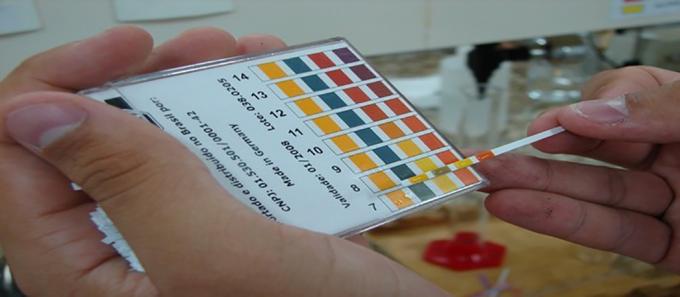O pH represents the hydrogen ion potential that a solution has, that is, the amount of hydronium cations (H+ or H3O+) that it has dispersed in the solvent.
The amount of ions of hydrogen it serves to measure the acidity, neutrality or alkalinity of a solution.
The determination of these indices only became possible when chemical scientists realized that water was a self-ionizable solution, that is, capable of producing hydroniums (H+) and hydroxides (OH–). Therefore, an aqueous solution will always have both types of ions.
Reference values for pH
You pH values are based on the ionization constant (Kw) of water which is 10-14 at a temperature of 25°C.
At this temperature, the concentration of hydronium and hydroxide ions are equal, being 10-7 mol/L for each.
From this, the values for pH were defined to vary between 0 and 14, pH 7 being a neutral solution, as is the case with pure water.
Solutions with pH values less than 7 are considered acidic and those with a pH value greater than 7 are considered basic or alkaline solutions.

Thus, the acid character is determined from right to left, in an increasing way, that is, the lower the pH value, the more acidic the solution will be.
The basic character is determined from left to right, in descending order, that is, the higher the pH value, the more alkaline the solution will be.
How to calculate pH?
O pH calculation was proposed by the Dane Soren Sörensen (1868–1939) who transformed the ion concentration values to logarithms.
pH = - log [H+]
Let's use water as an example:
Water has an ionic product 10–14 mol2/L2, if we apply the logarithm of her expression, we have:
- Free Online Inclusive Education Course
- Free Online Toy Library and Learning Course
- Free Online Math Games Course in Early Childhood Education
- Free Online Pedagogical Cultural Workshops Course
– log [H+] – log [OH-] = – log 10-14
pH + pOH = 14
Therefore:
pH = 14 - pOH
pOH = 14 - pH
How to measure pH?
Knowing the pH of a solution is important for both scientific and everyday uses, such as maintaining the quality of water in swimming pools and aquariums.
The pH of a solution can be measured using an acid-base indicator test or using a meter.
- Acid-base indicator: these are colored ribbons that change color indicating the character of the solution through a scale previously defined by the manufacturer. The most used are litmus and phenolphthalein.

- Pedometer: is an electronic instrument that measures the electrical conductivity of the solution and converts it to the pH scale.

Examples of solutions
acidic solutions
- Gastric juice: pH 2.0
- Lemon juice: pH 2.2
- Vinegar: pH 3.0
- Coffee: pH 5.0
- Cow's milk: pH 6.4
Basic or alkaline solutions
- Human blood: pH 7.35
- Sea water: pH 7.4
- Sodium bicarbonate: pH 8.4
- Milk of Magnesia: pH 10.5
- Bleach: pH 12.5
See too:
- selective permeability
- Blood plasma
- Synapses
The password has been sent to your email.

